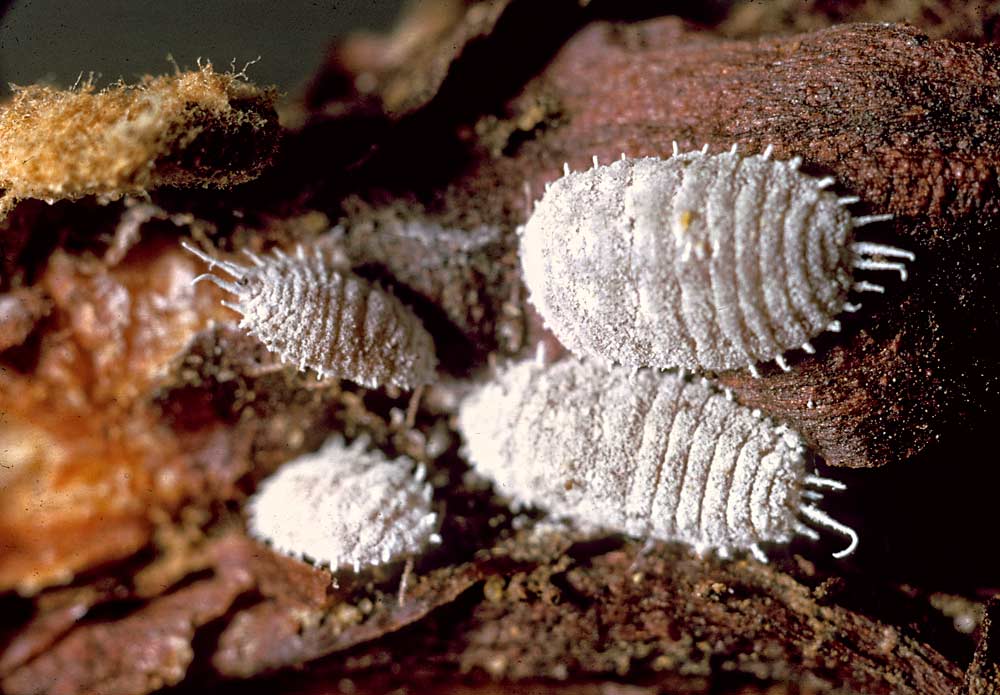
How many mealybugs does it take to spread grapevine leafroll disease in your vineyard?
Just one, according to Jonathan O’Hearn, who recently completed his doctorate at Washington State University, working with entomologist Doug Walsh.
“Every single mealybug has a 10 percent chance of moving the virus,” O’Hearn said when he presented his findings to the Washington State Grape Society in November. Grapevine leafroll disease is a destructive viral disease that reduces vine vigor, yield and fruit quality.
That makes the economic threshold for mealybugs zero when the virus is present in a vineyard, Walsh said in a follow-up interview. But in light of that finding, he still doesn’t recommend aggressive insecticide programs as a response.
Far from it, in fact. He recommends “rational mealybug management” — a program of two insecticide applications that’s enough to keep populations low. One spring chemigation with imidacloprid, followed by one foliar spray.
“We haven’t seen the disease spread any faster in those vineyards,” Walsh said, when compared to more intensive insecticide programs. “The difference between two and five applications is negligible.”
O’Hearn’s new data illustrate why. Using potted Chardonnay vines in the greenhouse, to which he added between one and 10 disease-carrying crawlers, he found that systemic insecticides such as imidacloprid, Movento (spirotetramat) and Sivanto (flupyradifurone) offered little disease control because the mealybugs can infect a vine before they are killed by the insecticides — even at higher rates.
“Is there a titer of insecticide that can kill the insect before it transmits the virus? The answer is no,” Walsh said.
Moreover, Walsh and O’Hearn reported the first warning signs of mealybugs developing imidacloprid resistance in a Washington wine grape vineyard. 2019 marked the first year of the study, which used a bioassay of leaves from vines exposed to varying doses of systemic insecticides. Then they compared the lethal result in two groups of mealybugs: a population from a wine grape vineyard that’s regularly sprayed; and a population collected in an organic pear block, which served as the control.
Walsh hopes to scale up to include more vineyards in coming years and build a more robust data set, but what he’s found so far shows significant decreases in the effectiveness of the insecticide in the vineyard population compared to the organic control.
“While I can’t come out and say it’s resistant yet, the train is on the track and it’s going that way,” Walsh said, adding that it’s not surprising. “Imidacloprid has been our first line of defense, and I understand why growers have been applying it like clockwork, because it’s cheap insurance.”
Growers have reported to him concerns about lack of reliable control with imidacloprid, compared to the past, which is what spurred him to do the research.
In the past, growers relied on a late dormant-season spray of Lorsban (chlorpyrifos) and oil to control mealybugs and cutworms, but moving away from that broad-spectrum program has enabled wine grape growers to benefit from biological control for many insect pests. Walsh, who helped to pioneer the integrated pest management approaches for Washington vineyards, said he’d hate to see growers go back to broad-spectrum sprays.
Which means the best solution for grapevine leafroll virus is to plant with clean plants and pull infected vines as soon as possible, so there is less disease inoculum present in vineyards to be spread by the few mealybugs that survive the modest management regime Walsh recommends.
That’s been the advice of WSU pathologist Naidu Rayapati for more than a decade now, although he acknowledges the challenge in detecting the disease, because its symptoms are varied by cultivar and can be easily confused with other viral diseases, such as grapevine red blotch.
On that front, Walsh offered some potentially good news. In California, the virus is vectored by treehoppers — specifically the three-cornered alfalfa treehopper, which is not present in Washington. (A close relative, the buffalo treehopper, is.) After two years of study to see if the buffalo treehopper can transmit the red blotch virus, Walsh said they have yet to see a positive transmission.
It’s possible the latent period of the virus is longer than two years before the pathogen reaches detectable levels, so he’s going to continue to watch the trial vines for signs of infection, but he’s optimistic.
“Red blotch has not been spreading in Washington anywhere near how it’s been spreading in California,” he said. •
—by Kate Prengaman






Leave A Comment